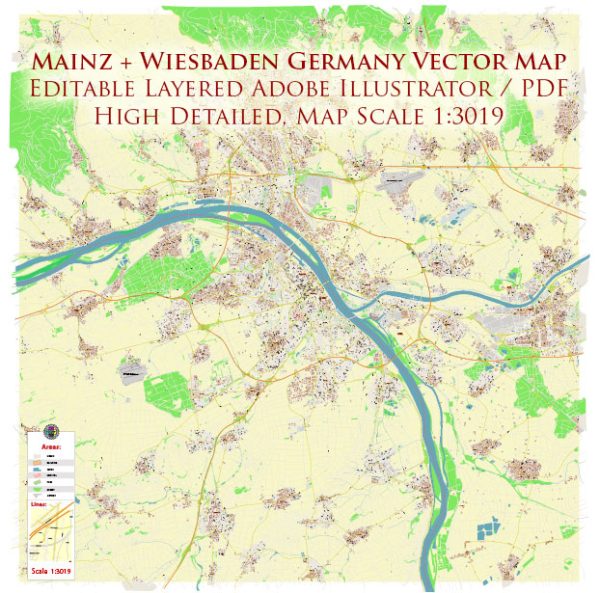Mainz / Wiesbaden, Germany, printable vector street map, City Plan, full editable, Adobe Illustrator, Royalty free, full vector, scalable, editable, text format street names, 13,3 mb ZIP
All streets, All buildings.
Map for design, print, arts, projects, presentations, for architects, designers and builders.
Different font colors of the street names (black); object names by type (brown, red).
DXF, DWG, CDR and other formats – on request, same price, please, contact
Mainz / Wiesbaden, Germany.
This vector map of Mainz + Wiesbaden is used as a basis for design, editing, and further printing.
This is the most detailed, exact map of Mainz + Wiesbaden for high-quality printing and polygraphy. You can always clarify the map development date by contacting us.
For your convenience, all objects on Mainz + Wiesbaden vector map are divided into layers. And the editing is very easy – colors, lines, etc.
You can easily add any objects needed (e.g. shops, salons, sale points, gas station or attraction) on any layer of Mainz + Wiesbaden vector map.
Mainz is the capital and largest city of Rhineland-Palatinate, Germany. The city is located on the Rhine river at its confluence with the Main river, opposite Wiesbaden on the border with Hesse. Mainz is an independent city with a population of 206,628 (2015) and forms part of the Frankfurt Rhine-Main Metropolitan Region.
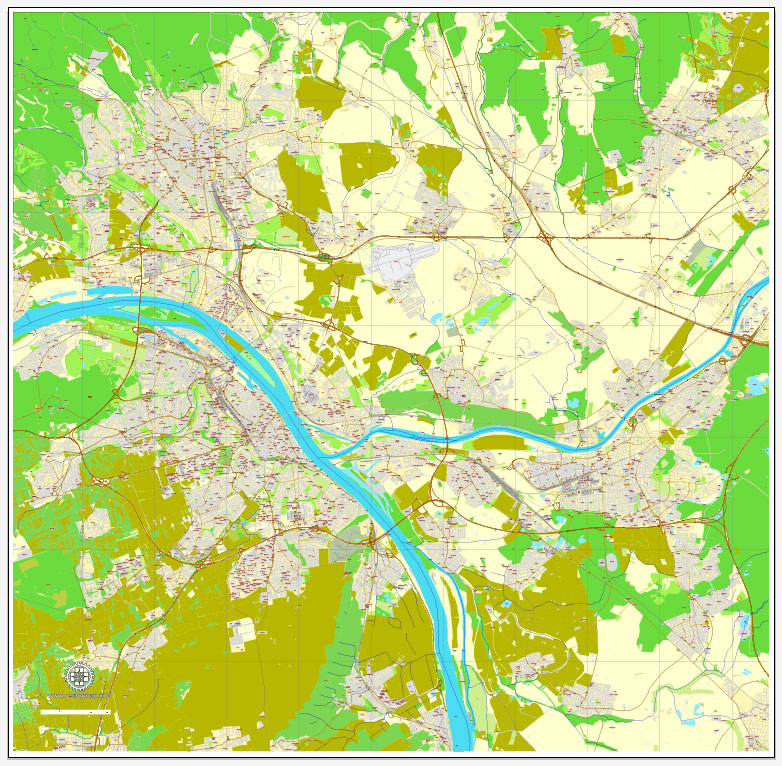
One of the advantages of Mainz + Wiesbaden vector maps of our production is the relevance of cartographic data, we constantly update all our products.
This vector map of Mainz + Wiesbaden is used by:
designers, layout designers, printers, advertisers and architects. Our product – vector maps – is designed for further editing and printing in large formats – from @Wall format (a few meters) to A-0 and A-1, A-2, A-3.
Mainz + Wiesbaden map in vector format is used for design, urban planning, presentations and media visualizations.
Advertising and presentation map of Mainz + Wiesbaden (usually the final designer marks the routes, and puts the client’s objects (shops, saloons, gas stations etc.)
The undoubted advantage is that people will NEVER throw out this advertising product – the map. In fact, as an advertising medium, a map is the most “long-playing” of the well-known polygraphic advertising media, with the longest lifespan, and the maximum number of interactions with the customer.
For travelers, maps are sold at the airports and gas stations around the world. Often the source is our vector maps.
Take a look, who purchases our vector maps of Mainz + Wiesbaden in “Our Clients and Friends” page – these are large and small companies, from super-brands like Volvo and Starbucks, to small design studios and printing houses.
It’s very easy to work with vector maps of Mainz + Wiesbaden, even for a not very experienced designer who can turn on and off the map layers, add new objects, change the colors of fill and lines according to customer requirements.
The undoubted advantage of Mainz + Wiesbaden vector maps in printing is an excellent and detailed visualization, when customer can expand a large paper map and instantly define his location, find a landmark, an object or address on map, unlike using the popular electronic formats of Google and Yandex maps for example.
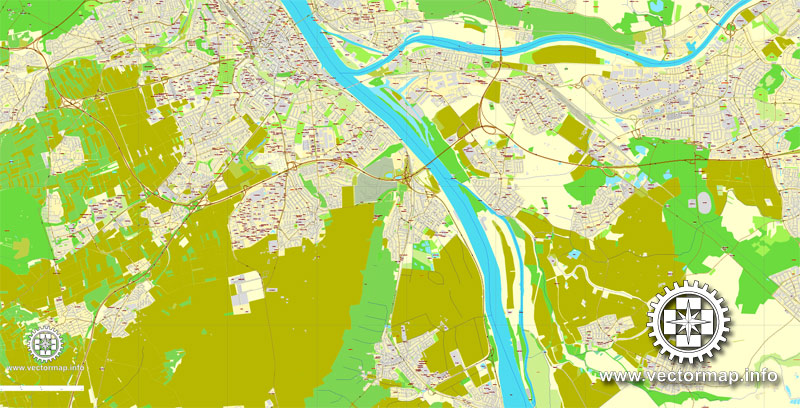
Printable vector maps of Mainz + Wiesbaden are much more convenient and efficient than any electronic maps on your smartphone, because ALL DETAILS are displayed in the entire space of Mainz + Wiesbaden map.
Useful tips on working with vector maps of cities and countries in Adobe Illustrator.
«V» – launches the Selection tool (cursor, black arrow), which makes active any vector line.
«А» – launches the Direct Selection tool (white cursor), allows you to select curve elements and drag them to the desired place.
«R» – activates the Rotate tool, which helps you rotating selected objects around the center point by 360 degrees.
«E» – gives you the opportunity to use the Eraser tool and erase unnecessary parts.
«X» – switches between Fill and Stroke in the Tools section. Try to get used to this hot key and
you will quickly understand that you can’t live and work without it.
Guides are not limited to vertical and horizontal in Adobe Illustrator. You can also create a diagonal guide for example. Moreover, you can turn any contours into guides. Select the outline and go to View > Guides > Make Guides (Create Guides), or simply press Cmd/Ctrl + 5. You can also turn the guides back into an editable object. Go to menu, View > Guides > Unlock Guides (Release Guides), select the guide you want to edit and select View > Guides > Release Guides (Reset Guides), or just press Cmd/Ctrl + Option / Alt + 5).
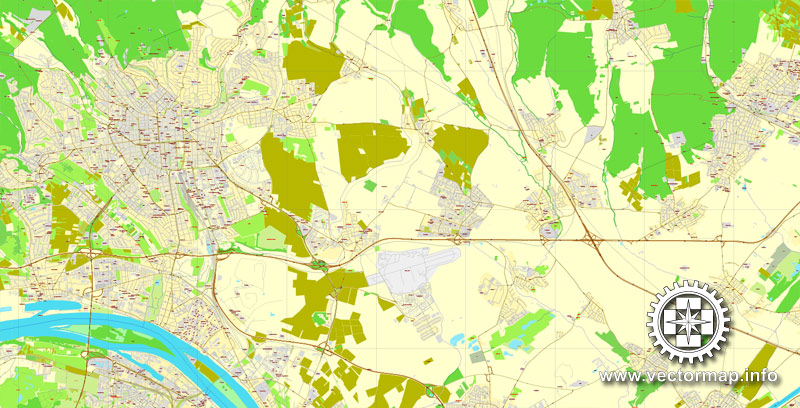
You will probably want to change the color scheme used on our Mainz + Wiesbaden vector map.
To quickly and effectively play with colors.
Of course, you can do it manually, all objects in our Mainz + Wiesbaden vector map are divided according to types and layers, and you can easily change the color gamma of vector objects in groups and layers.
But there is more effective way of working with the whole VECTOR MAP of Mainz + Wiesbaden and all layers:
The overview dialog «Edit colors»/«Repaint Graphic Object» (this dialog box name can change depending on the context):
If you have selected a part or a layer of Mainz + Wiesbaden vector map and open the dialog box by clicking the icon in the Control panel, on the Samples palette or the Color Catalog, or if you choose Edit > Edit Colors> Repaint Graphic Object, then the «Repaint Graphic Object» dialog box appears, and you get access to «Assign» and «Edit» tabs.
If a picture or a map fragment is not selected, and you open the dialog box by clicking the icon in the Control panel, on the Samples palette or in the Color Catalog, the «Edit Colors» dialog box appears and you can only access the «Edit» tab.
Regardless of the name at the top of the dialog box, the right-hand side always displays the color group of the current document, as well as two default color groups: Print Color and Grayscale. These color groups can be selected and used any time.
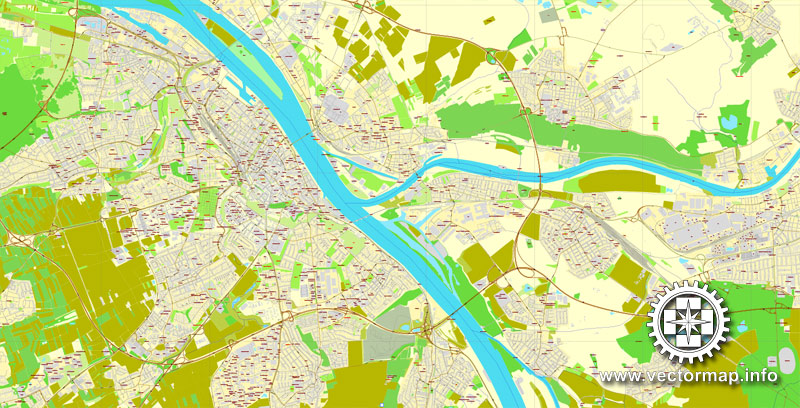
Create and edit color groups of Mainz + Wiesbaden vector map, and also assign colors using the «Edit Colors»/ а «Repaint Graphic Object» dialog box.
A. Creating and editing of a color group on the «Edit» tab
B. Assigning colors on the «Assign» tab
C. Select a group of colors from the «Color groups» list
The option «Repaint a graphic object» in the lower part of the dialog box allows you to preview the colors on a selected layer of Vector map, or a group of elements, and specify whether its colors will be redefined when the dialog box is closed.
The main areas of the dialog box are:
«Edit»
The «Edit» tab is designed to create a new or edit the existing color groups.
The harmony rules Menu and the Color Wheel are used to conduct experiments with color harmonies. The color wheel shows how colors are related in color harmony, and the color bars allow you to view and manipulate an individual color values. In addition, you can adjust the brightness, add and remove colors, save color groups and view colors on the selected Vector Map of Mainz + Wiesbaden or a separated layers.
«Assign»
The «Assign» tab is used to view and control on how the original colors are replaced with colors from the color group like your corporate colors in the Vector Map of Mainz + Wiesbaden.
The assign color ability is provided only if the entire map, layer or fragment is selected in the document. You can specify which of new colors replace the current colors, whether the spot colors should be preserved and how colors are replaced (for example, you can replace colors completely or changing the color tone while maintaining the brightness). The «Assign» tab allows you to redefine colors in the Vector Map of Mainz + Wiesbaden, or in separate layers and fragments using the current color group or reducing the number of colors in the current Vector Map.
Color groups
Is a list of all saved color groups for current document (the same groups appear in the «Samples» palette). You can edit and delete the existing color groups, as well as creating a new ones using the list of “Color Groups” in the dialog box. All changes appear in the «Samples» palette.
The highlighted color group shows, which color group is currently edited.
Mainz was founded by the Romans in the 1st Century BC during the Classical antiquity era, serving as a military fortress on the northernmost frontier of the Roman Empire and as the provincial capital of Germania Superior. Mainz became an important city in the 8th Century AD as part of the Holy Roman Empire, becoming the capital of the Electorate of Mainz and seat of the Archbishop-Elector of Mainz, the Primate of Germany. Mainz is famous as the home of Johannes Gutenberg, the inventor of the movable-type printing press, who in the early 1450s manufactured his first books in the city, including the Gutenberg Bible. Historically, before the 20th century, the city was known in English as Mentz and in French as Mayence. Mainz was heavily damaged during World War II, with more than 30 air raids destroying about 80 percent of the city’s center, including most of the historic buildings. Today, Mainz is a transport hub and a center of wine production.
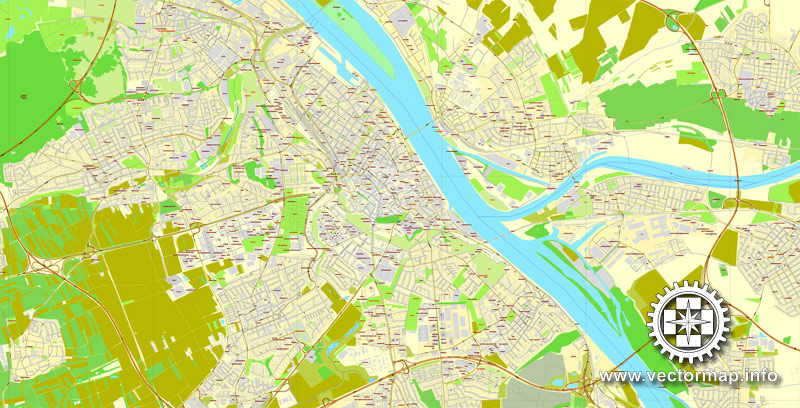
Any color group can be selected and edited, or used to redefine the colors in the selected vector map of Mainz + Wiesbaden, its fragments or elements.
Saving a color group adds this group to the specified list.
Opening the «Edit Colors»/«Repaint Graphic Object» dialog box.
Open the «Edit Colors»/«Repaint Graphic Object» dialog box using one of the following methods:
«Edit»> «Edit Colors»> «Repaint Graphic object» or «Repaint With Style».
Use these commands if you need to edit the colors in the selected vector map of Mainz + Wiesbaden.
«Repaint Graphic object» button on the «Control» panel.
Use this button if you need to adjust colors of Mainz + Wiesbaden vector map using the а «Repaint graphic object» dialog box.
The specified button is available if the selected vector map or its fragment contains two or more colors.
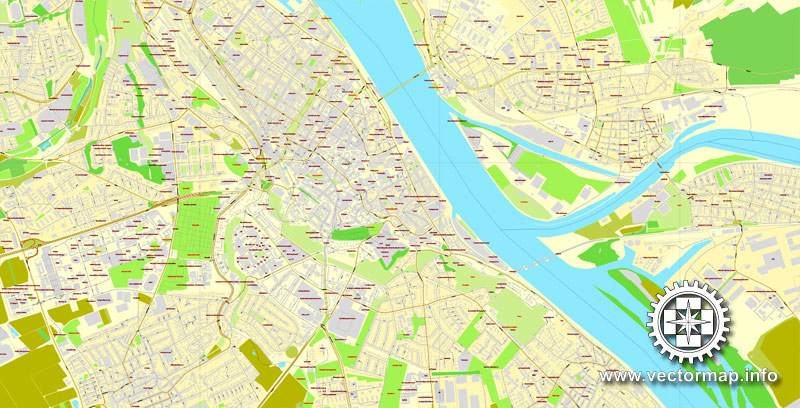
Note. This color editing method is convenient for global color adjustment in a vector map, if global colors were not used when creating a Map of Mainz + Wiesbaden.
The «Edit colors» button or «Edit or apply colors» on the «Color Catalog» palette
Click this button if you need to edit colors on the «Color Catalog» palette or edit and then apply them to the selected Vector Map of Mainz + Wiesbaden or its fragment.
The «Edit color group» button or «Edit or apply color group» on the «Samples» palette.
Click this button if you need to edit the colors in the specific color group or edit and apply them to the selected Vector Map of Mainz + Wiesbaden or a group of its elements, for example, the whole layer “Streets and lines”. You can also double-click the color group in the Samples panel to open the dialog box.
If the map file is too large and your computer freezes or even can’t open it quickly:
1. Try to reduce the color resolution of the video card (display) to 256 colors while working with a large map.
2. Using Windows Task Manager, select all the application you don’t need, while working with map, just turn them off.
3. Launch Adobe Illustrator. (DO NOT OPEN the vector map file)
4. Start the Windows Task Manager using administrator rights > Find the “Illustrator” process > set the «real time» priority,
5. Open the file. When you see the LEGACY FONT popup window – click “OK” (do not update). You can restore the TEXT later.
6. Can also be useful: When file is opened – Edit > Settings > Basic Settings > disable smoothing. /// It looks scary, but works quickly)))
We recommend saving the file in Adobe Illustrator 10 version. It’s much more stable when working with VERY BIG size files.
Topography
Mainz is located on the 50th latitude, on the left bank of the river Rhine, opposite the confluence of the Main with the Rhine. The population in the early 2012 was 200,957, an additional 18,619 people maintain a primary residence elsewhere but have a second home in Mainz. The city is part of the Rhein Metro area comprising 5.8 million people. Mainz can easily be reached from Frankfurt International Airport in 25 minutes by commuter railway (Line S8).
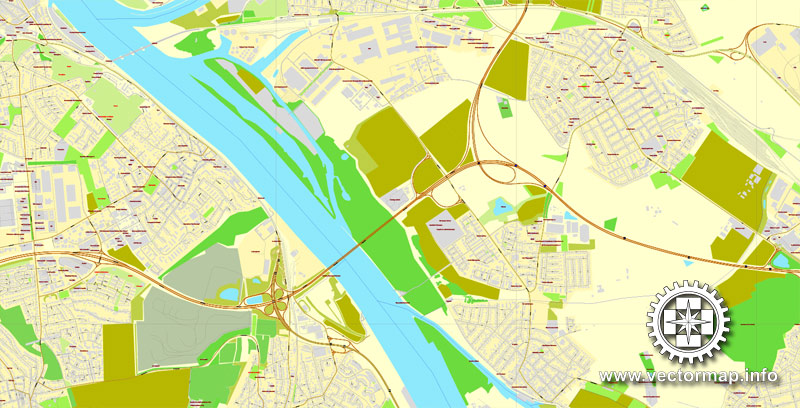
Mainz is a river port city as the Rhine which connects with its main tributaries, such as the Neckar, the Main and, later, the Moselle and thereby continental Europe with the Port of Rotterdam and thus the North Sea. Mainz’s history and economy are closely tied to its proximity to the Rhine historically handling much of the region’s waterborne cargo. Today’s huge container port hub allowing trimodal transport is located on the North Side of the town. The river also provides another positive effect, moderating Mainz’s climate; making waterfront neighborhoods slightly warmer in winter and cooler in summer.
After the last ice age, sand dunes were deposited in the Rhine valley at what was to become the western edge of the city. The Mainz Sand Dunes area is now a nature reserve with a unique landscape and rare steppe vegetation for this area.
While the Mainz legion camp was founded in 13/12 BC on the Kästrich hill, the associated vici and canabae were erected in direction to the Rhine. Historical sources and archaeological findings both prove the importance of the military and civilian Mogontiacum as a port city on the Rhine.
Wiesbaden is a city in central western Germany and the capital of the federal state of Hesse. In January 2018, it had 289,544 inhabitants, plus approximately 19,000 United States citizens (mostly associated with the United States Army). The Wiesbaden urban area is home to approx. 560,000 people.
The city, together with nearby Frankfurt am Main, Darmstadt, and Mainz, is part of the Frankfurt Rhine Main Region, a metropolitan area with a combined population of about 5.8 million people.
Wiesbaden is one of the oldest spa towns in Europe. Its name translates to “meadow baths”, a reference to the hot springs. It is internationally famous for its architecture, climate (it is also called the “Nice of the North”), and hot springs. At one time, Wiesbaden boasted 26 hot springs. Fourteen of the springs are still flowing today.
In 1970, the town hosted the tenth Hessentag state festival.
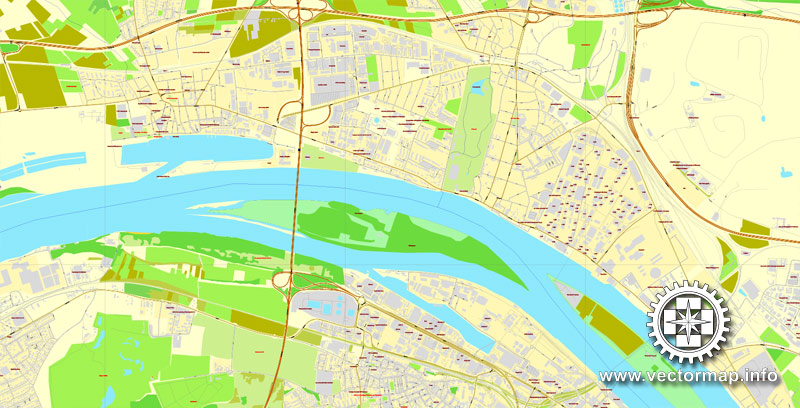
The city is considered the tenth richest in Germany (2014) boasting 110.3% of the national average gross domestic product in 2017. The average annual buying power per citizen is €24,783.
Wiesbaden is situated on the right (northern) bank of the Rhine, below the confluence of the Main, where the Rhine’s main direction changes from north to west. The city is across the Rhine from Mainz, the capital of the federal state of Rhineland-Palatinate. Frankfurt am Main is located about 38 kilometres (23.6 mi) east. To the north of the city are the Taunus Mountains, which trend in a northeasterly direction.
The city center, the Stadtmitte, is located in the north-easternmost part of the Upper Rhine Valley at the spurs of the Taunus mountains, about 5 kilometres (3.1 mi) from the Rhine. The landscape is formed by a wide lowland between the Taunus heights in the north, the Bierstadter Höhe and the Hainerberg in the east, the Mosbacher Mountain in the south, and the Schiersteiner Mountain in the west, an offshoot of the Taunus range. The downtown is drained only by the narrow valley of the Salzbach, a tributary of the Rhine, on the eastern flanks of the Mosbacher Mountain. The city’s main railway line and the Mainz road (Mainzer Straße) follow this valley. Several other streams drain into the Salzbach within the city center: the Wellritzbach, the Kesselbach, the Schwarzbach, the Dambach, and the Tennelbach, as well as the outflow of many thermal and mineral springs in the Kurhaus (spa) district. Above the city center, the Salzbach is better known as the Rambach.
The highest point of the Wiesbaden municipality is located northwest of the city center near the summit of the Hohe Wurzel, with an elevation of 608 metres (1,995 ft) above sea level. The lowest point is the harbour entrance of Schierstein at 83 metres (272 ft) above sea level. The central square (the Schlossplatz, or palace square) is at an elevation of 115 metres (377 ft).
Wiesbaden covers an area of 204 km2 (79 sq mi). It is 17.6 kilometres (10.9 mi) from north to south and 19.7 kilometres (12.2 mi) from west to east. In the north are vast forest areas, which cover 27.4% of the urban area. In the west and east are vineyards and agricultural land, which cover 31.1% of the area. Of the municipality’s 79 kilometres (49.1 mi)-long border, the Rhine makes up 10.3 kilometres (6.4 mi).
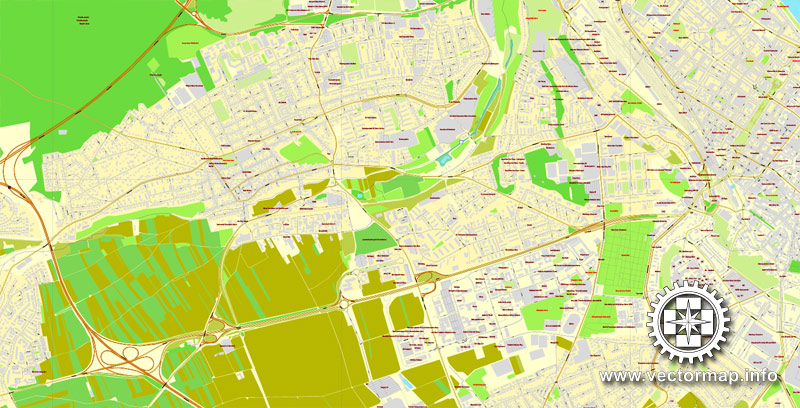
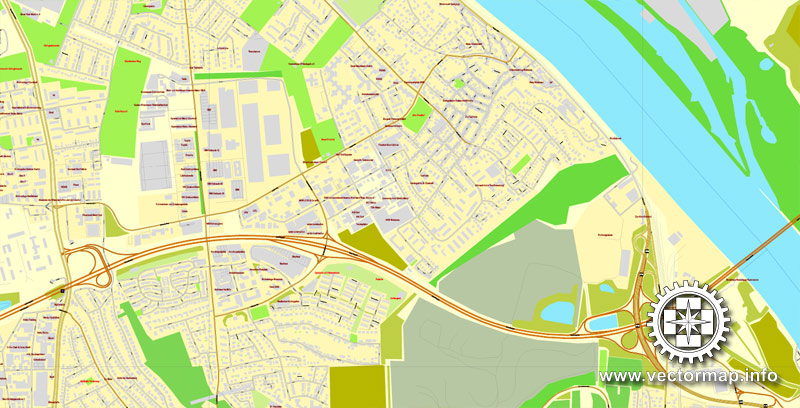
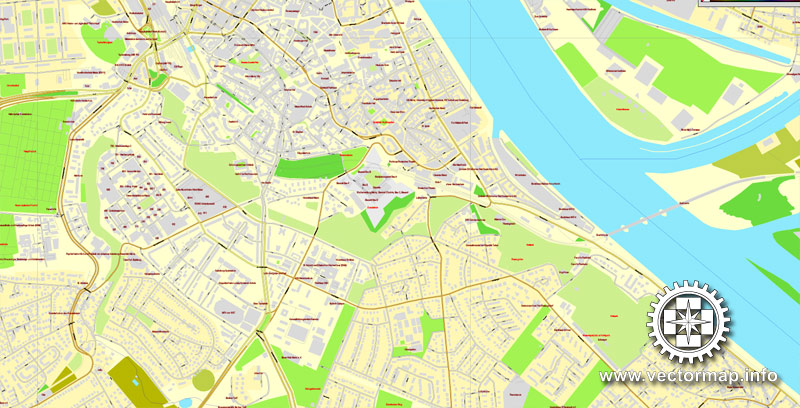
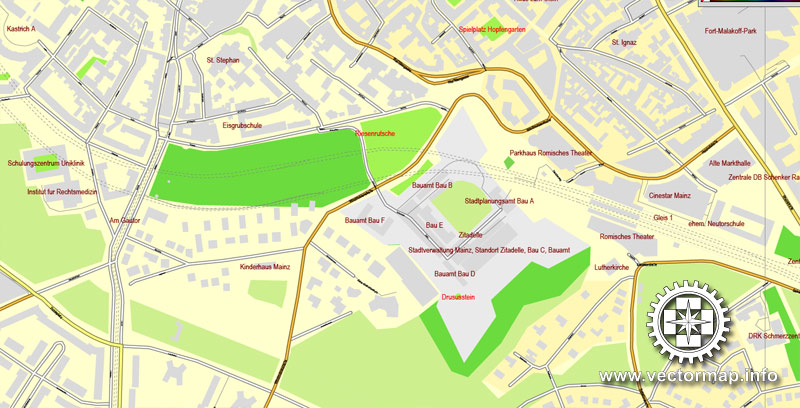
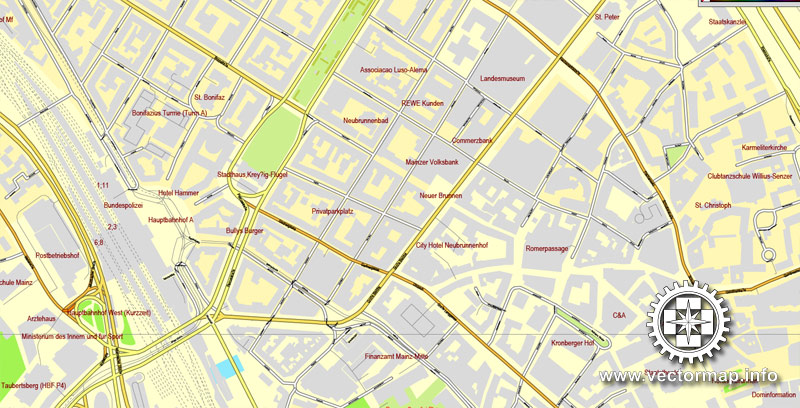
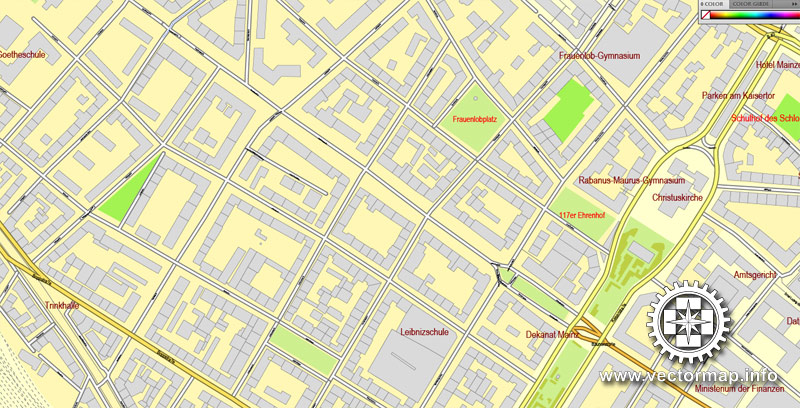
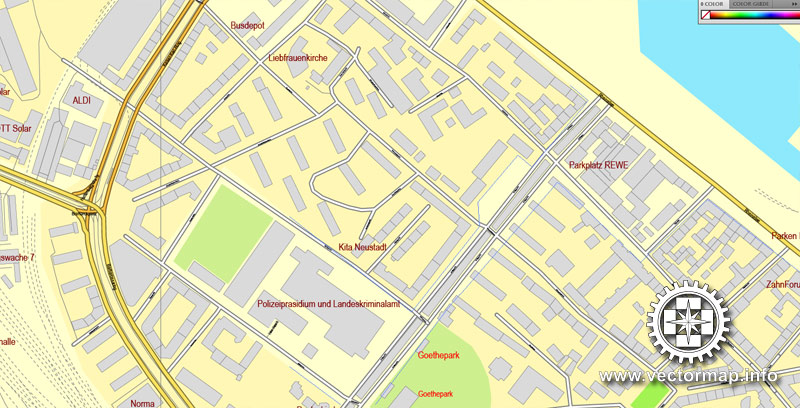
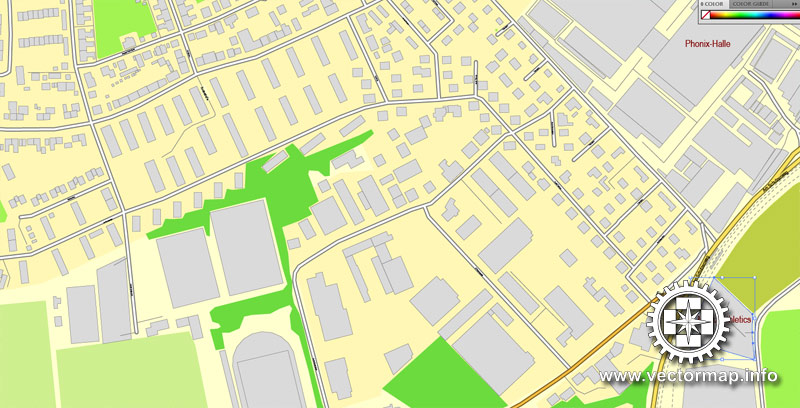

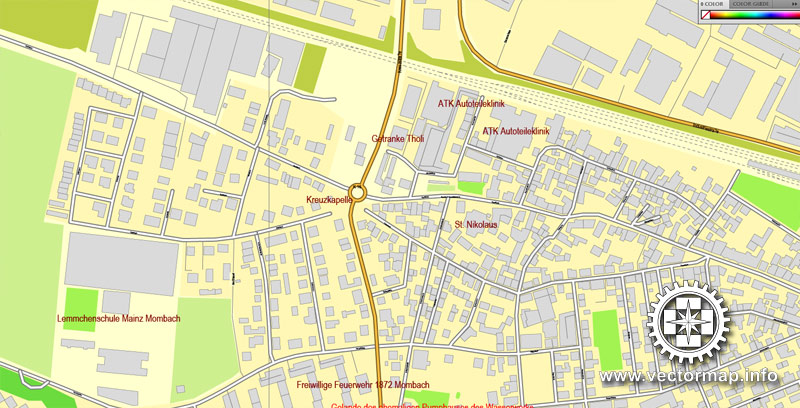
Mainz
City in Germany
Mainz is the capital of the state of Rhineland-Palatinate in Germany. It was the capital of the Electorate of Mainz at the time of the Holy Roman Empire.
Area: 97.75 km²
Population: 202,756 (2013) UNdata
Number of airports: 1
Mainz is the capital of the state of Rhineland-Palatinate in Germany. It was the capital of the Electorate of Mainz at the time of the Holy Roman Empire. In antiquity Mainz was a Roman fort city which commanded the west bank of the Rhine and formed part of the northernmost frontier of the Roman Empire; it was founded as a military post by the Romans in the late 1st century BC and became the provincial capital of Germania Superior. The city is located on the river Rhine at its confluence with the Main opposite Wiesbaden, in the western part of the Frankfurt Rhine-Main; in the modern age, Frankfurt shares much of its regional importance.
The city is famous as the home of the invention of the movable-type printing press, as the first books printed using movable type were manufactured in Mainz by Gutenberg in the early 1450s. Until the twentieth century, Mainz was usually referred to in English by its French name: Mayence.
Source Wiki
Wiesbaden
City in Germany
Wiesbaden is a city in central western Germany and the capital of the federal state of Hesse. It has about 273,000 inhabitants, plus approximately 19,000 United States citizens.
Area: 203.9 km²
Population: 272,636 (2013) UNdata
Administrative region: Darmstadt
Wiesbaden is a city in central western Germany and the capital of the federal state of Hesse. It has about 273,000 inhabitants, plus approximately 19,000 United States citizens (mostly associated with the United States Army).
The city, together with nearby Frankfurt am Main, Darmstadt and Mainz, is part of the Frankfurt Rhine Main Region, a metropolitan area with a combined population of about 5.8 million people.
Wiesbaden is one of the oldest spa towns in Europe. Its name translates to “meadow baths,” making reference to the hot springs. It is internationally famous for its architecture, climate (also called the “Nice of the North”), and its hot springs. At one time, Wiesbaden boasted 26 hot springs. Fourteen of the springs are still flowing today.
In 1970, the town hosted the tenth Hessentag state festival.
The city is considered the tenth richest in Germany (2014) with 113.3% of gross domestic product. Every citizen has an average annual buying power of €24,798.
Source Wiki
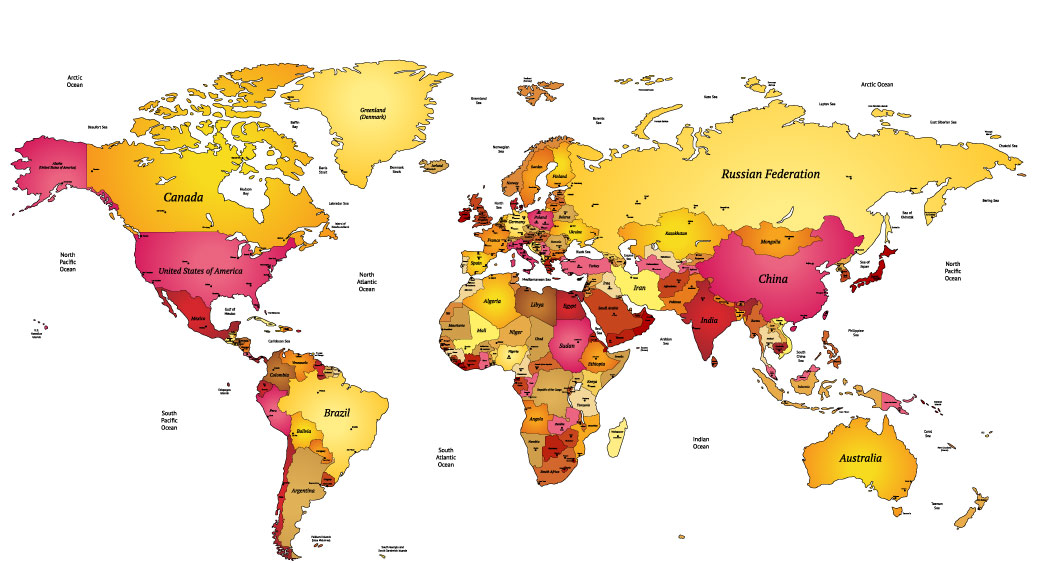
Free vector map World, Adobe Illustrator, download now maps vector clipart Map for design, projects, presentation free to use as you like. World map vector, Vector world map, World vector map, Map western europe, West europe maps, Map of the world modifiable, High resolution world map, World map illustrator, World map PDF editable, World vector map download,
Free vector map World, Adobe Illustrator, download now maps vector clipart
Map for design, projects, presentation free to use as you like.
Free Download All World Vector Maps here >>>>>
See also: TERMS & CONDITIONS: SOFTWARE LICENSE AGREEMENT FOR DIGITAL CARTOGRAPHIC DATA
Small guide: How to work with the vector map?
You can: Mass select objects by type and color – for example, the objects type “building” (they are usually dark gray) – and remove them from the map, if you do not need them in your print or design project. You can also easily change the thickness of lines (streets), just bulk selection the road by the line color.
The streets are separated by type, for example, type “residential road” are usually white with a gray stroke. Highway usually orange with a brown or dark gray stroke.
All objects are divided by types: different types of roads and streets, polygons of buildings, landfills, urban areas, parks and more other.
It is easy to change the font of inscriptions, all or each individually. Also, just can be make and any other manipulation of objects on the vector map in Adobe illustrator format.
Important: All the proportions on the map are true, that is, the relative sizes of the objects are true, because Map is based on an accurate GPS projection, and It transated into the (usual for all) the Mercator projection.
You can easily change the color, stroke and fill of any object on the map, zoom without loss of quality Image Verification.
Select object

Bulk selection the same objects on the vector map

See the bulk selected objects on the vector map

Bulk delete buildungs from the vector map

Select residencial road (small street) on the vector map

Bulk selection the same lines (streets, roads) on the full map

Create fat lines of the streets on the vector maps (bulk action) 1

Create fat lines of the streets on the vector maps (bulk action) 2

Create fat lines of the streets on the vector maps (bulk action) 3

You can easily change the color, stroke and fill of any object on the map, zoom without loss of quality Image Verification.






























 Author: Kirill Shrayber, Ph.D.
Author: Kirill Shrayber, Ph.D.